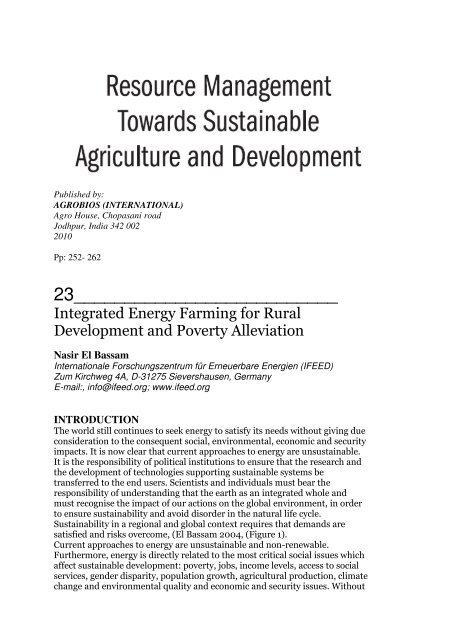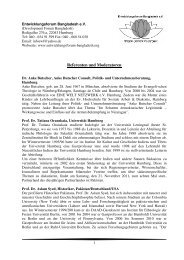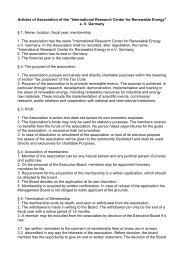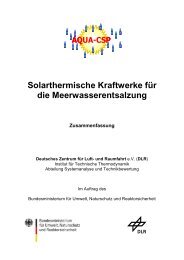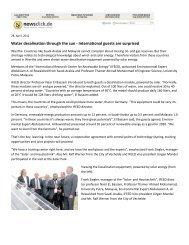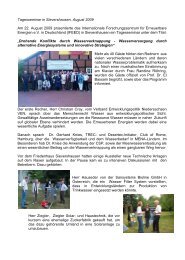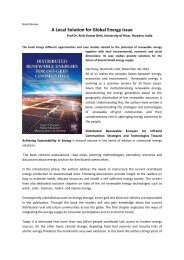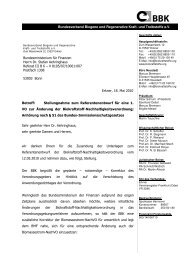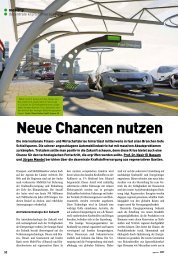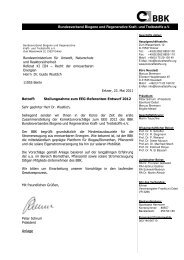Open document... - IFEED
Open document... - IFEED
Open document... - IFEED
Create successful ePaper yourself
Turn your PDF publications into a flip-book with our unique Google optimized e-Paper software.
Published by:<br />
AGROBIOS (INTERNATIONAL)<br />
Agro House, Chopasani road<br />
Jodhpur, India 342 002<br />
2010<br />
Pp: 252- 262<br />
23__________________________<br />
Integrated Energy Farming for Rural<br />
Development and Poverty Alleviation<br />
Nasir El Bassam<br />
Internationale Forschungszentrum für Erneuerbare Energien (<strong>IFEED</strong>)<br />
Zum Kirchweg 4A, D-31275 Sievershausen, Germany<br />
E-mail:, info@ifeed.org; www.ifeed.org<br />
INTRODUCTION<br />
The world still continues to seek energy to satisfy its needs without giving due<br />
consideration to the consequent social, environmental, economic and security<br />
impacts. It is now clear that current approaches to energy are unsustainable.<br />
It is the responsibility of political institutions to ensure that the research and<br />
the development of technologies supporting sustainable systems be<br />
transferred to the end users. Scientists and individuals must bear the<br />
responsibility of understanding that the earth as an integrated whole and<br />
must recognise the impact of our actions on the global environment, in order<br />
to ensure sustainability and avoid disorder in the natural life cycle.<br />
Sustainability in a regional and global context requires that demands are<br />
satisfied and risks overcome, (El Bassam 2004, (Figure 1).<br />
Current approaches to energy are unsustainable and non-renewable.<br />
Furthermore, energy is directly related to the most critical social issues which<br />
affect sustainable development: poverty, jobs, income levels, access to social<br />
services, gender disparity, population growth, agricultural production, climate<br />
change and environmental quality and economic and security issues. Without
adequate attention to the critical importance of energy to all these aspects, the<br />
global social, economical and environmental goals of sustainability cannot be<br />
achieved. Indeed, the magnitude of change needed is immense, fundamental<br />
and directly related to the energy produced and consumed nationally and<br />
internationally. The key challenge to realizing these targets is to overcome the<br />
lack of commitment and to develop the political will to protect people and the<br />
natural resource base. Failure to take action will lead to continuing<br />
degradation of natural resources, increasing conflicts over scarce resources<br />
and widening gaps between rich and poor. We must act while we still have<br />
choices. Implementing sustainable energy strategies is one of the most<br />
232 Resource Management Towards Sustainable Agriculture and Development<br />
important levers humankind has for creating a sustainable world. More than<br />
two billion people, mostly living in rural areas, have no access to modern<br />
energy sources. Food and fodder availability is very closely related to energy<br />
availability.<br />
Figure 1: Sustainability in regional and global context demands, risks and measures<br />
(El Bassam<br />
2004).<br />
Integrated Energy Farms (IEF) for Food and Energy -<br />
The Concept of FAO of the United Nations
In order to meet challenges, future energy policies should put more emphasis<br />
on developing the potential of energy sources, which should form the<br />
foundation of future global energy structure. In this context, the FAO of the<br />
United Nations in support of the Sustainable Rural Energy Network (SREN)<br />
has developed the concept for the optimisation, evaluation and<br />
implementation of integrated renewable farms for rural communities under<br />
different climatic and environmental conditions (El Bassam 1999).<br />
Milestones<br />
The IEF concept includes farms or decentralised living areas from which the<br />
daily necessities (water, food and energy) can be produced directly on-site<br />
with minimal external energy inputs. (Figure 2, 3)<br />
Energy production and consumption at the IEF has to be environmentally<br />
friendly, sustainable and ultimately based mainly on renewable energy<br />
sources. It includes a combination of different possibilities for non-polluting<br />
energy production, such as modern wind and solar electricity production, as<br />
well as the production of energy from biomass.<br />
Energy Farming and Rural Development 233<br />
It should seek to optimise energetic autonomy and an ecologically semiclosed<br />
system, while also providing socio-economic viability and giving due<br />
consideration to the newest concept of landscape and bio-diversity<br />
management.<br />
The concept considers the following needs of the rural population to<br />
improve their living conditions and raise their living standards and to improve<br />
the environment:
Figure 2: Basic elements and needs of integrated renewable energy community (el<br />
bassam 2001).<br />
1 Heat<br />
Heat can be generated from biomass or solar thermal to create both high<br />
temperature steam and low temperature heat for: space heating, domestic and<br />
industrial hot water, pool heating, desalination, cooking and crop drying.<br />
2 Electric Power<br />
Solar PV, Solar thermal, biomass, wind, micro-hydro<br />
3 Water (Drinking and Irrigation)<br />
Water is an essential resource for which there can be no substitute. Renewable<br />
energy can play a major role in supplying water in remote areas. Several<br />
systems could be adopted for this purpose:<br />
• Solar distillation.<br />
234 Resource Management Towards Sustainable Agriculture and Development<br />
• Renewable energy operated desalination units.<br />
• Solar, wind and biomass operated water pumping and distribution<br />
systems.<br />
4 Lighting and Cooling<br />
In order to improve living standards and encourage the spread of education in<br />
rural areas, a supply of electricity is vital. Several systems could be adopted to<br />
generate electricity for lighting and cooling<br />
• Solar systems (photovoltaic and solar thermal)<br />
• Wind energy systems<br />
• Biomass and biogas systems (engines, fuel cells, Stirling)<br />
5 Cooking
Women in rural communities spend long hours collecting fire wood and<br />
preparing food. There are other methods which are more efficient, healthy<br />
and environmentally benign. Among them are:<br />
• Solar cookers and ovens Biogascooking systems<br />
• Improved biomass stoves using briquettes and pellets<br />
• Plant oil and ethanol cookers<br />
6 Health and Sanitation<br />
To improve serious health problems among villagers, solar energy from<br />
photovoltaic, wind and biogas could be used to operate:<br />
• Refrigerators for vaccine and medicine storage<br />
• Sterilizers for clinical items<br />
• Waste water treatment units<br />
• Ice making<br />
7 Communications<br />
Communication systems are essential for rural development. The availability<br />
of these systems has a great impact on people’s lives and can advance their<br />
development process more rapidly. Electricity can be generated from any<br />
renewable energy source to operate the basic communication needs such as:<br />
radio., television, weather information systems, and mobile telephone.<br />
8 Transportation<br />
Improved transportation in rural areas and villages has a positive effect on the<br />
economic situation as well as the social relation between the people of these<br />
areas. Several methods could be adapted for this purpose.<br />
• Solar electric vehicles<br />
Energy Farming and Rural Development 235<br />
• Ethanol, plant oil fuel, hydrogen vehicles (engines, fuel cells)<br />
• Traction animals.<br />
9 Food and Agriculture<br />
In rural areas agriculture represents a major energy end use. Mechanization<br />
using renewable sources of energy can reduce the time spent in labor intensive<br />
processes, freeing time for other income producing activities. Renewable<br />
sources of energy can be applied to:<br />
• Soil preparation and harvesting:<br />
• Husking and milling of grain<br />
• Crop drying and preservation<br />
• Textile processing<br />
The concept of an Integrated Energy Farm (IEF) or settlement includes 4<br />
pathways (Figure 4):<br />
1. Economic and social pathway;<br />
2. Energy pathway;<br />
3. Food pathway; and<br />
4. Environmental pathway.<br />
Basic Elements of Integration<br />
Basic data should be collected for the verification of an IEF. Various climatic<br />
constraints, water availability, soil conditions, infrastructure, availability of<br />
skills and technology, population structure, flora and fauna, common<br />
agricultural practices and economic, educational and administrative facilities<br />
in the region should be taken into consideration. Moreover, climate also<br />
influences the production of energy-mix (consisting of biomass, wind and<br />
solar energies) essentially at a given location; and the type of technology that
can be installed also depends decisively on the climatic conditions of the<br />
locality in question. For example, cultivation of biomass for power generation<br />
is not advisable in arid areas.<br />
It is evident that throughout Europe, wind and biomass energies<br />
contribute the major share to the energy-mix, while in North Africa and the<br />
Sahara the main emphasis obviously lies with solar and wind energies.<br />
Equatorial regions offer great possibilities for solar as well as biomass<br />
energies and little share is expected from the wind source of energy in these<br />
regions. Under these assumptions, in Southern Europe, the Equatorial regions<br />
and North and Central Europe, a farm area of 4.8, 10 and 12 ha, respectively,<br />
would be needed for the cultivation of biomass for energy purposes. This<br />
would correspond to annual production of 36, 45 and 60 tonnes for the<br />
respective regions. In North Africa and Sahara regions, in addition to wind<br />
and solar energy, 14 tonnes of biomass from 1.2% of the total area would be<br />
necessary for energy provisions. Projection steps are illustrated in Figure 5.<br />
236 Resource Management Towards Sustainable Agriculture and Development<br />
Figure 3: A model for an Integrated Energy Farm for, El Bassam 2001.
Figure 4: Pathways of the Integrated Energy Farms (IEF).<br />
Energy Farming and Rural Development 237<br />
Implementation Procedure
Figure 5: Projection steps of IEF.<br />
Moving ahead, in order to broaden the scope and seek the practical<br />
feasibility of such farms, the dependence of local inhabitants (end users) is to<br />
be integrated in this system. Roughly 500 persons (125 households) can be<br />
integrated in one farm or rural settlement unit. They have to be provided with<br />
food as well as energy. As a consequence, the estimated extra requirement of 1<br />
900 MWh of heat and 600 MWh of power has to be supplied from alternative<br />
sources. Under the assumption that the share of wind and solar energy in the<br />
complete energy provision remains at the same level, the production of 450<br />
tonnes of dry biomass is needed to fulfil the demands of such farm units. For<br />
the production of this quantity of biomass, 20% of farm area needs to be<br />
dedicated for cultivation. In Southern Europe and the Equator, 15% of the
land area should be made available for the provision of additional biomass.<br />
238 Resource Management Towards Sustainable Agriculture and Development<br />
Climatic conditions prevailing in a particular region are the major<br />
determinants of agricultural production. In addition to that, other factors like<br />
local and regional needs, availability of resources and other infrastructure<br />
facilities also determine the size and the product spectrum of the farmland.<br />
The same requisites also apply to an IREF. The climate fundamentally<br />
determines the selection of plant species and their cultivation intensity for<br />
energy production on the farm. Moreover, climate also influences the<br />
production of energy-mix (consisting of biomass, wind and solar energies)<br />
essentially at a given location; and the type of technology that can be installed<br />
also depends decisively on the climatic conditions of the locality in question.<br />
For example, cultivation of biomass for power generation is not advisable in<br />
arid areas. Instead a larger share can be allocated to solar energy techniques<br />
in such areas. Likewise, coastal regions are ideal for wind power installations.<br />
Food and Energy Plantations<br />
More than 50 crops have been identified in different regions of the world to<br />
serve as sources for biofuels. Selected crops which can be grown under various<br />
climatic conditions is <strong>document</strong>ed in Tables 1, 2 and 3.<br />
Table 1: Representative crops for temperate regions
Table 2: Representative crops for arid and semi-arid regions<br />
Table 3: Representative energy crops for tropical and sub-tropical regions<br />
OUTLOOK<br />
Measures to overcome the problems of food, water and energy supply in<br />
Developing countries are essential and continually attracting the attention of<br />
Governments, the international lending agencies, non-governmental<br />
organizations and the various stakeholders. This project is aiming to deepen<br />
the discussions, for the main purposes of elucidating the issues and finding<br />
the appropriate answers that will keep the world on a much more robust<br />
growth path, and towards achieving key targets of the MDGs. However, the<br />
great challenge facing sub-Saharan African economies is how to reduce<br />
poverty by half, before the year 2015, in line with the first objective of the<br />
Millennium Development Goals (MDGs). Specifically, the targets are to:<br />
reduce by half the proportion of people living on less than a dollar a day and<br />
as well reduce by half the proportion of people who suffer from hunger. In<br />
addition, Africa has multiple energy technologies to satisfy the needs of 30%
of the population, in urban areas. The rural areas, where the remaining 70%<br />
live, have limited energy choices. It must be a priority for African<br />
governments to ensure that the rural majority has access to the same choices<br />
as those who live in urban areas (Davidson and Sokona, 2001).<br />
These goals call for GDP growth rates even higher than the current<br />
achievement. The implication is for higher levels of domestic investment and<br />
productivity of the economy. In order to achieve this goal, real GDP growth<br />
rates should be 7% or more per annum. Yet the productivity and overall<br />
performance of sub-Saharan African economies is being hampered by the<br />
state of the Energy Sector. Lack of energy services or poor access to this<br />
resource, are likely some of the factors militating against sub-Saharan African<br />
economies in achieving higher potentials of their economies.<br />
Electricity accounts for only 4% of Sub-Saharan Africa’s total energy<br />
consumption, yet it is a most vital input in the production processes and in the<br />
delivery of the social services, namely education and health care services.<br />
240 Resource Management Towards Sustainable Agriculture and Development<br />
Electric power is a catalyst for social and economic development. In Africa,<br />
electric energy is provided mainly from fossil fuels and hydropower.<br />
Electricity consumption is also the lowest, on a regional basis, at about<br />
515 kwh/per annum compared to the world average of 2,326 kwh/per annum.<br />
Out of the total Sub-Saharan Africa population of 743 million, over 500<br />
million or 67% lack access to electricity services. Also, the MDG goals in the<br />
education and health-care sectors are being compromised by the lack of<br />
electricity, as majority of schools and health-care centers cannot function<br />
properly. Inadequate lighting or illumination in schools is not conducive to<br />
learning. There is undue reliance on standby generators or kerosene lamps<br />
that are not safe. Africa Energy Commission (AFREC)<br />
The importance of modern energy provision in African development<br />
cannot be over-emphasised, as it is the nucleus of socio-economic<br />
development worldwide. However, large numbers of Africans depend instead<br />
on firewood and charcoal, reflecting the comparatively low level of<br />
industrialisation on the continent. Moving out of this stage requires a<br />
substantial increase in cost-effective and affordable energy sources, while<br />
minimising environmental hazards and ensuring social equitability and<br />
sustainability. For Africa to be competitive, its per capita primary energy<br />
needs to be increased. In comparison with the rest of the world, Africans are<br />
among the smallest consumers of primary energy.<br />
REFERENCES AND SUGGESTED READINGS<br />
Africa Energy Commission (AFREC) 2007<br />
BP 2001. BP statistical review of world energy, June 2001. London: BP.<br />
Business Times of Nigeria, February 10, 2008.<br />
Chiaramonti, D., P. Grimm, M. Cendagorta and N. El Bassam (1998), Small energy<br />
farm scheme implementation for rescuing deserting land in small Mediterranean<br />
islands, coastal areas, having water and agricultural land constraints, Feasibility<br />
study, in Proceedings of the 10th International<br />
Conference “Biomass for Energy and Industry”, Würzburg, 1259-62.<br />
Davidson, O R and Sokona, Y (2001). Energy and sustainable development: Key<br />
issues<br />
for Africa. In Wamukonya, N (ed) Proceedings of the African High-level Regional
Meeting on Energy and Sustainable Development. Roskilde: UNEP: 1-20.<br />
El Bassam, N. (1996). Renewable energy - potential energy crops for Europe and the<br />
Mediterranean region, REU Technical Series 46, Food and Agriculture<br />
Organization of the United Nations (FAO),200 S, Rome.<br />
El Bassam, N. (1998a). “Biological Life Support Systems Under Controlled<br />
Environments” in El Bassam, N. et al. (eds.), Sustainable Agriculture for Food,<br />
Energy and Industry<br />
El Bassam, N. (1998b). Energy Plant Species – Their Use And Impact on<br />
Environment<br />
And Development<br />
El Bassam, N. (1999). Integrated Energy Farm Feasibility Study, SREN-FAO.<br />
El Bassam, N. (2001). “Renewable Energy for Rural Communities”, Renewable<br />
Energy<br />
El Bassam N. (2004). Integrated Renewable Energy Farms for Sustainable<br />
Development Rural Communities. In Biomass and Agriculture, OECD Publication,<br />
Paris, pp 262- 276. www.oecd.org/agr/env<br />
Energy Farming and Rural Development 241<br />
FAO (2008). The MINISTERIAL CONFERENCE ON WATER FOR AGRICULTURE<br />
AND ENERGY IN AFRICA. Document (FAO, Sirte/08/INF/4).<br />
Forum of Energy Ministers of Africa, Report on the FEMA Ministerial Meeting,<br />
Entebbe, Uganda, (2005).<br />
IMF Survey, Volume 37, No. 3, March 2008.<br />
International Council of Science (ICSU), Regional Office for Africa: Sustainable<br />
Energy<br />
in sub-Saharan Africa, July 2007.<br />
IZNE 2005 The Bioenergy Village Self-sufficient Heating and Electricity Supply<br />
Using<br />
Biomass. www.bioenergiedorf.de<br />
James and James Science Publishers, Volume 2, pp. 1214-1216, London.<br />
James and James Science Publishers, ISBN 1-873936-70-2, 321 pp, London.<br />
Nachwachsende Rohstoffe, 2008 www.nachwachsende-rohstoffe.de<br />
Njuguna A. E. and Stephen N. Karinji: Macroeconomic Policy Space and Africa<br />
Economies: An empirical Shifting through reality and Rhetoric, African Economic<br />
Conference, November 15-17, 2007, Addis Ababa, Ethiopia.<br />
Ruwisch V. B. Sauer 2007 Bioenergy Village Jühnde: Experiences in rural<br />
selfsufficiency.<br />
I, IZNE www.bioenergiedorf.de<br />
Teyssen, J., World Energy Council Europe, Energy Development in Africa,<br />
Sustainability Symposium, TU Delft, November 2, 2007.<br />
The World Bank, (2007), World Development Indicators 2007, Washington D.C.,<br />
USA<br />
http://www.sirtewaterandenergy.org/docs/2009/MAP.df www.Fao.org/nr./water<br />
2009


